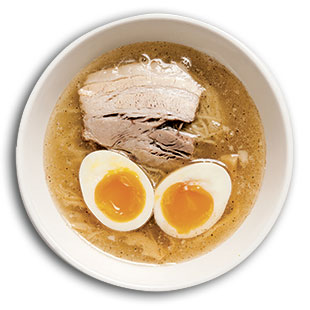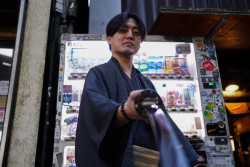
Originally published on metropolis.co.jp on November 2013

“For a long time, eggs weren’t a traditional ramen topping; they were offered hardboiled and unpeeled in a basket for customers to pluck out and eat while they waited or to add to their soup. As ramen became more refined and less junk-foody, cooks started to treat the eggs with more care. The eggs they sell in Japan are beyond delicious, and to me, they’re an indispensable part of a bowl of ramen. We serve hanjuku tamago, half-cooked eggs, which have a firm but soft white and a mostly liquid yolk.
My search for perfect eggs took me to innumerable egg farms. After an extensive search, I found one that tasted great, had the most brilliant orange yolks and peeled easily. (Believe me, when you have to peel two hundred eggs a day, that’s an important criterion.) Then I spent almost as much time figuring out how to cook the eggs properly as I did perfecting the noodles. But I’ve got it now: punch a pinhole in the bottom, boil for six minutes and ten seconds, stirring gently for the first two minutes then ice immediately. Once they’re cool, the eggs are peeled and soaked in a light shoyu tare (or, preferably, reserved chashu cooking liquid). Sliced in half and served at room temperature atop the ramen, the eggs are a perfect supporting cast member for the soup and noodles, adding an extra touch of color and unctuousness to the bowl.”
HALF-COOKED EGGS
Servings: 6
- 50 milliliters sake
- 50 milliliters mirin
- 200 milliliters soy sauce
- 30 grams sugar
- 40 grams garlic, chopped coarsely
- 75 grams fresh ginger, chopped coarsely
- 6 room-temperature fresh, large eggs
- 1 liter water
Simmer the sake and mirin in a saucepan over medium-high heat for two minutes to cook off a bit of the alcohol. Reduce the heat to low, then add the soy sauce, sugar, garlic, and ginger and simmer and stir for 10 minutes. Let come to room temperature; you can store the mixture in the refrigerator for up to a week.
Bring a large pot of water to a boil. You want a big pot so that when the eggs go in, the temperature won’t drop too drastically, and the water will quickly come back to a boil.
Poke a small hole in the bottom (larger end) of each egg with a pushpin.
Gently slide the eggs into the boiling water. Start your timer. Stir for the first two minutes. Prepare a large bowl of ice water to shock the eggs.
The total cooking time for a large egg in Tokyo is six minutes and ten seconds. You might decide to adjust that time depending on the size of your eggs, how many you’re cooking, or what the chickens were thinking about when they laid them.
Remove the eggs after six minutes and ten seconds, and immediately place them in the ice bath. Stir until there are no pockets of hot water.
In a large bowl, combine the shoyu tare with the liter of water. When the eggs are cooled completely—after about 15 minutes—peel and soak them in the seasoning liquid for two hours in the refrigerator. The eggs will hold in the soak for three days.
When it comes time to slice the eggs and add them to the ramen, a taut nylon fishing line gets the job done without losing any of the precious yolk.
Reprinted with permission from Ivan Ramen by Ivan Orkin © 2013. Published by Ten Speed Press, a division of Random House, Inc.







